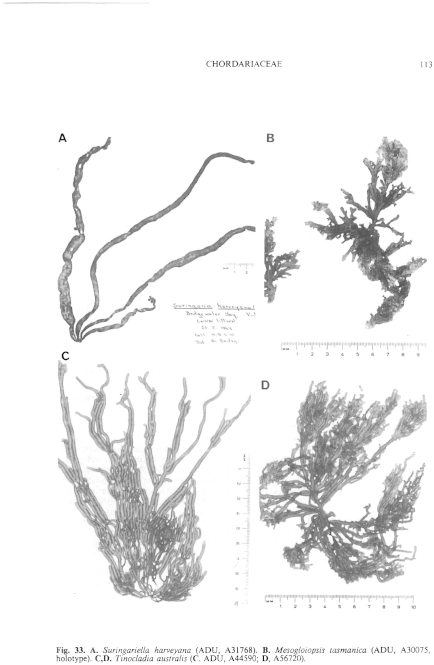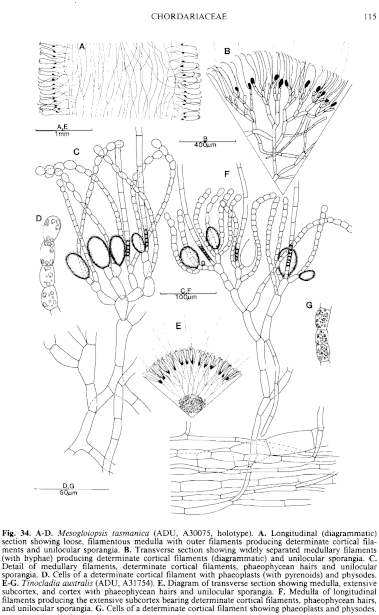|
|
|
|
|
|||||||||||
|
Electronic Flora of South Australia Species Fact Sheet
Phylum Phaeophyta – Order Chordariales – Family Chordariaceae
Thallus (Fig. 33B) medium to dark brown, very mucoid, much branched with short, stout, and irregularly arranged laterals, 5–10 cm long and (1–) 2–4 mm in diameter, cylindrical, apparently with a holdfast 3–4 mm across, epilithic. Medulla (Fig. 34A,B) at first of branched filaments bearing the cortex, soon becoming largely replaced by slender, longitudinally orientated but loosely associated, branched, hyphal filaments, 10–15 µm in diameter with cells L/B 5–10 (–20), probably remaining solid; outer part of medulla (Fig. 34B) consisting of radially orientated filaments, branched at wide angles, with some anastomoses resulting from union between rhizoids and filament cells, and with the cells widely separated by mucilage, cells 20–30 µm in diameter and L/B (2–) 3–5 (–10), cylindrical to slightly inflated. Cortical filaments (Fig. 34B,C) arising in groups from outer medullary cells, simple, 200–300 µm and 10–18 cells long, usually slightly curved above, with upper cells ovoid to isodiametric, 12–14 µm in diameter and L/B 1–2, often slightly enlarged on their upper side, lower cells cylindrical, 6–8 µm in diameter and L/B 1–2; intercalary divisions present. Phaeoplasts (Fig. 34D) several per cell but usually sparse, discoid, each probably with a pyrenoid; physodes few. Phaeophycean hairs (Fig. 34B,C) arising from outer medullary cells, 8–10 µm in diameter.
Reproduction: Unilocular sporangia (Fig. 34C) borne on outer medullary cells at base of cortical filaments, ovoid to broadly clavate, 40–70 µm long and 25–30 µm in diameter. Plurilocular sporangia unknown.
Type from Tesselated Pavement, Eaglehawk Neck, Tasmania, upper sublittoral to lower eulittoral (Gordon, 13.i.1966); holotype in ADU, A30075.
Distribution: Known from the type and Rocky Cape, N. Tas., upper sublittoral to lower eulittoral (Gordon, 18.i.1966; ADU, A30048).
Taxonomic notes: M. tasmanica is known only from the above two collections, and is probably a summer annual as are most Chordariaceae. Study of fresh collections is needed to clarify the number of filaments in the apparently multiaxial apices, but the species appears to be distinct from other known taxa of the family.
References: The Marine Benthic Flora of Southern Australia Part II
Publication:
Womersley, H.B.S. (14 December, 1987)
The Marine Benthic Flora of Southern Australia
Part II
©Board of the Botanic Gardens and State Herbarium, Government of South Australia
Illustrations in Womersley Part II, 1997: FIGS 33B, 34 A–D.

Figure 33 enlarge
Fig. 33. A. Suringariella harveyana (ADU, A31768). B. Mesogloiopsis tasmanica (ADU, A30075, holotype). C,D. Tinocladia australis ( C, ADU, A44590; D, A56720).

Figure 34 enlarge
Fig. 34. A–D. Mesogloiopsis tasmanica (ADU, A30075, holotype). A. Longitudinal (diagrammatic) section showing loose, filamentous medulla with outer filaments producing determinate cortical filaments and unilocular sporangia. B. Transverse section showing widely separated medullary filaments (with hyphae) producing determinate cortical filaments (diagrammatic) and unilocular sporangia. C. Detail of medullary filaments, determinate cortical filaments, phaeophycean hairs and unilocular sporangia. D. Cells of a determinate cortical filament with phaeoplasts (with pyrenoids) and physodes. E–G. Tinocladia australis (ADU, A31754). E. Diagram of transverse section showing medulla, extensive subcortex, and cortex with phaeophycean hairs and unilocular sporangia. F. Medulla of longitudinal filaments producing the extensive subcortex bearing determinate cortical filaments, phaeophycean hairs, and unilocular sporangia. G. Cells of a determinate cortical filament showing phaeoplasts and physodes.

|
Email Contact: State Herbarium of South Australia |

|